Control work for the 3 term
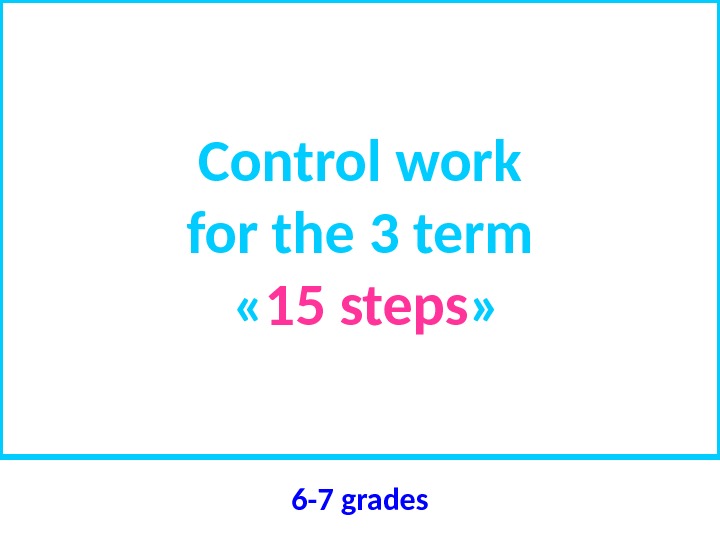
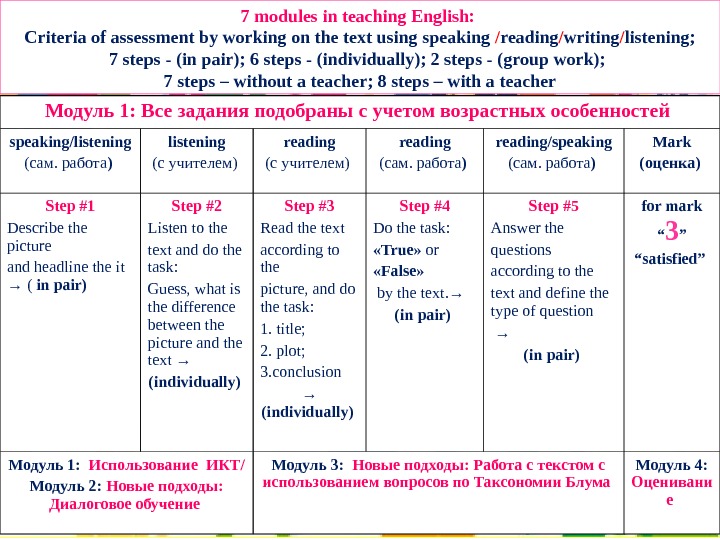

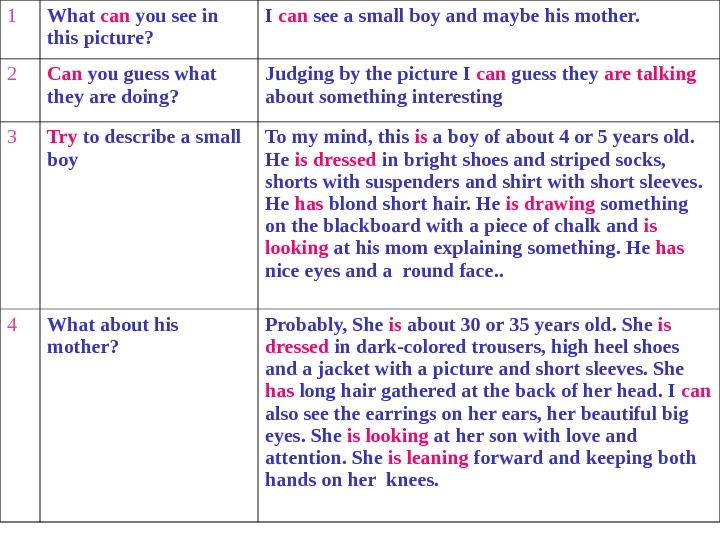
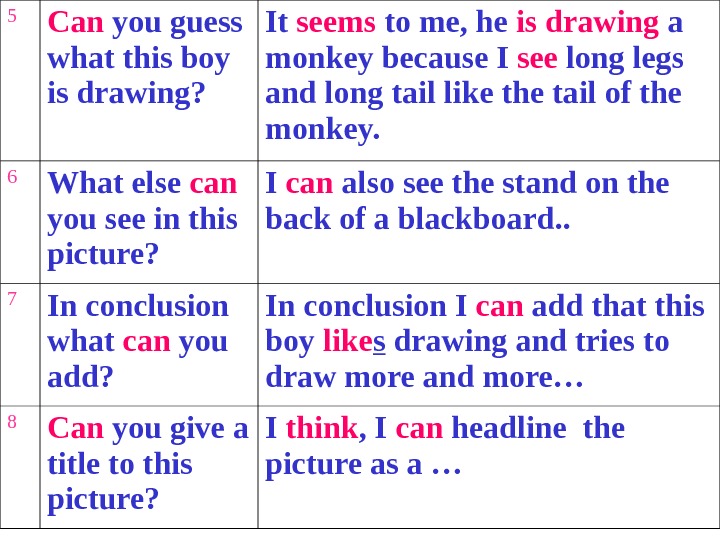

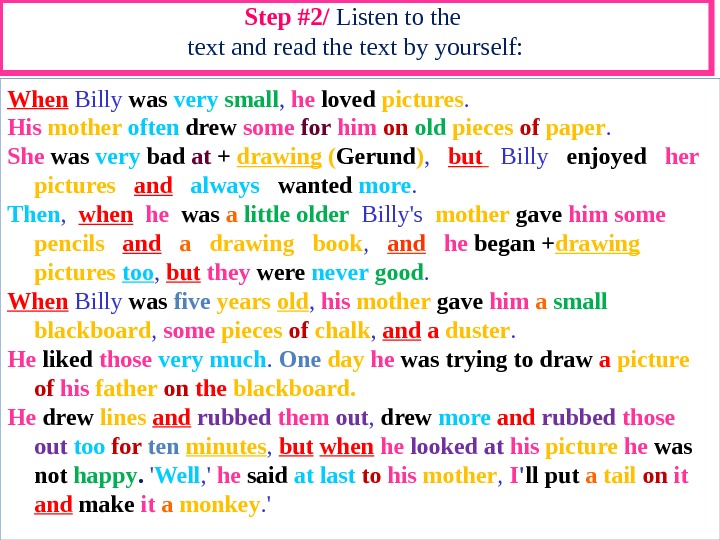
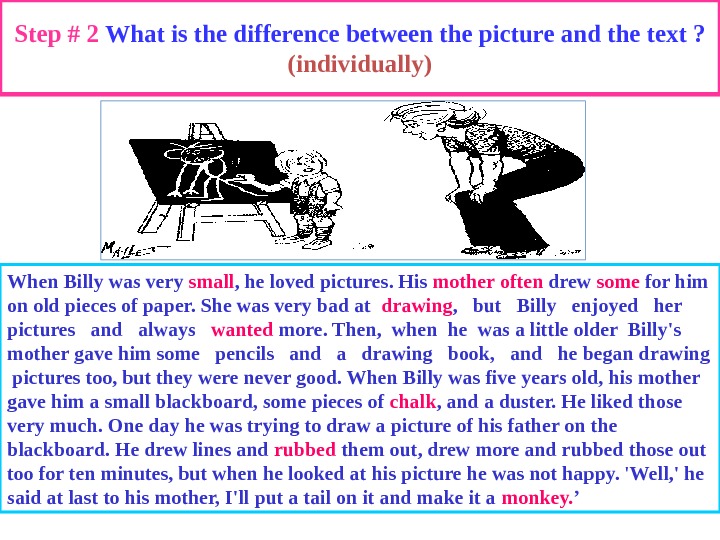

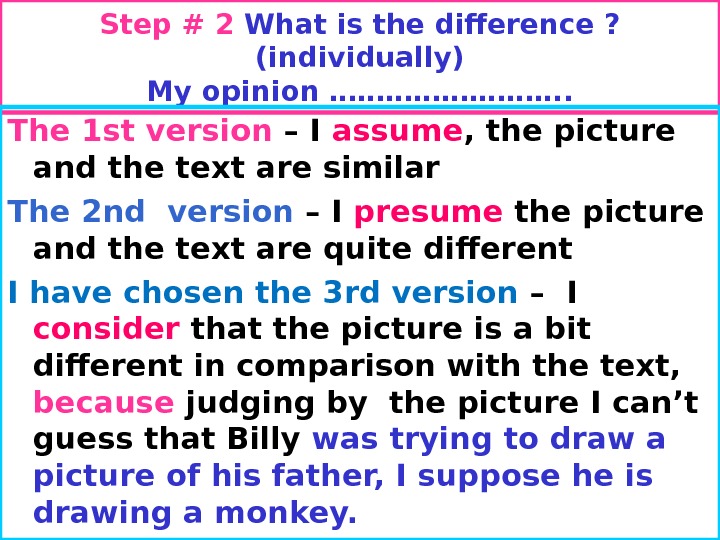
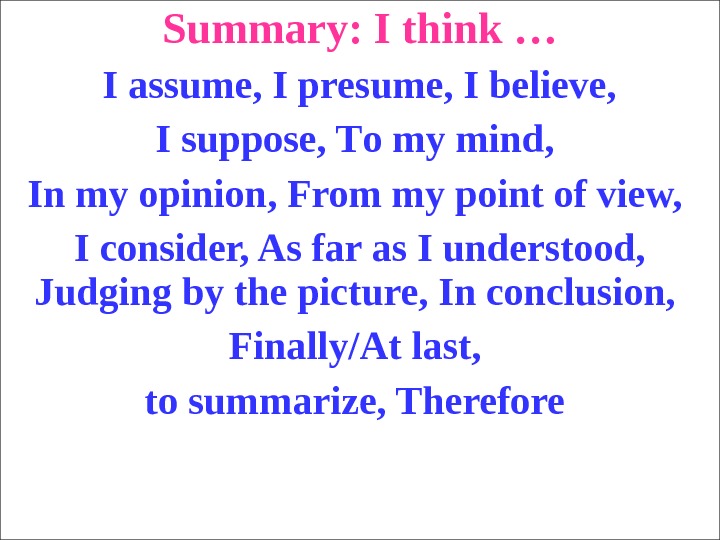

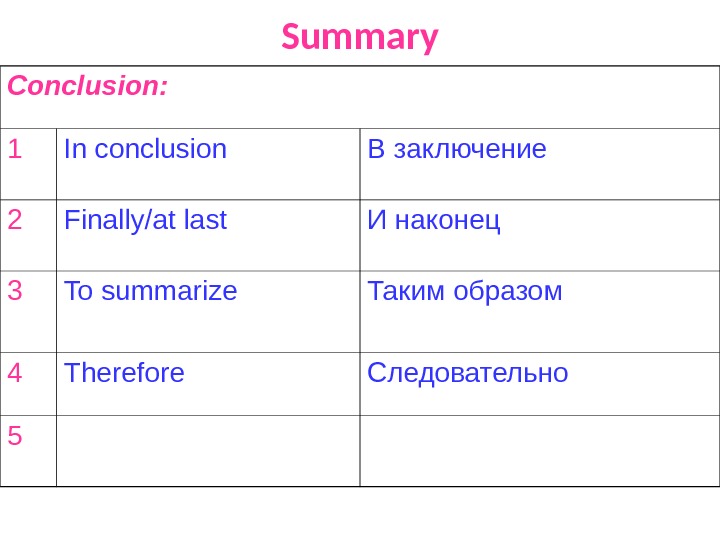

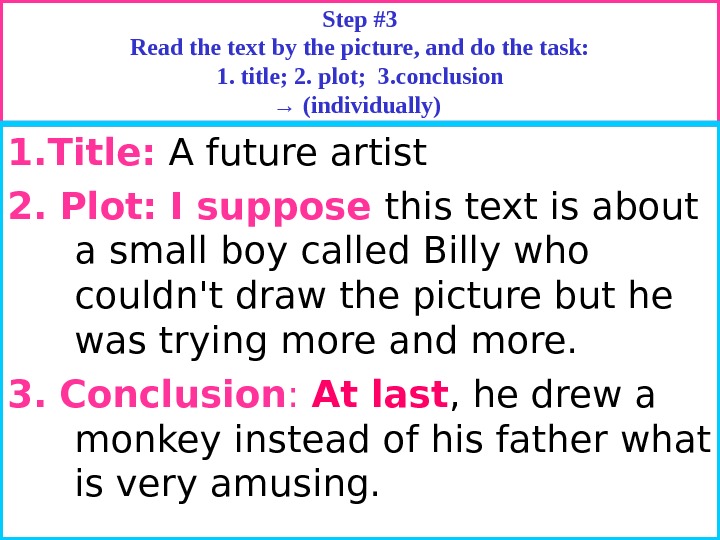

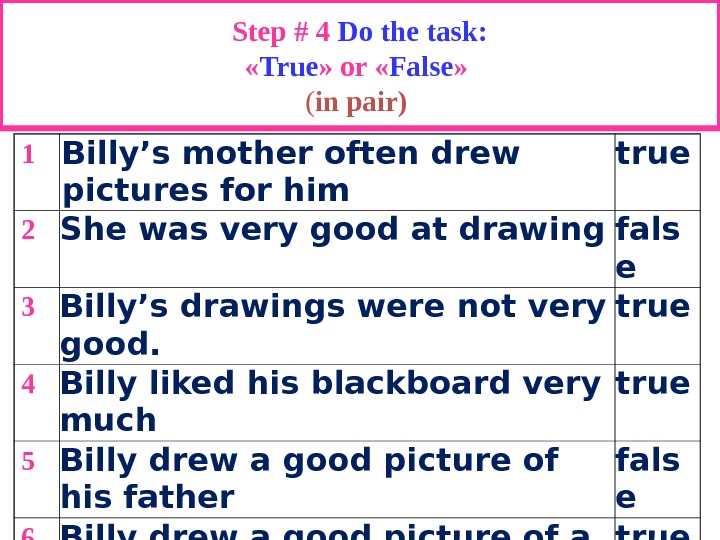
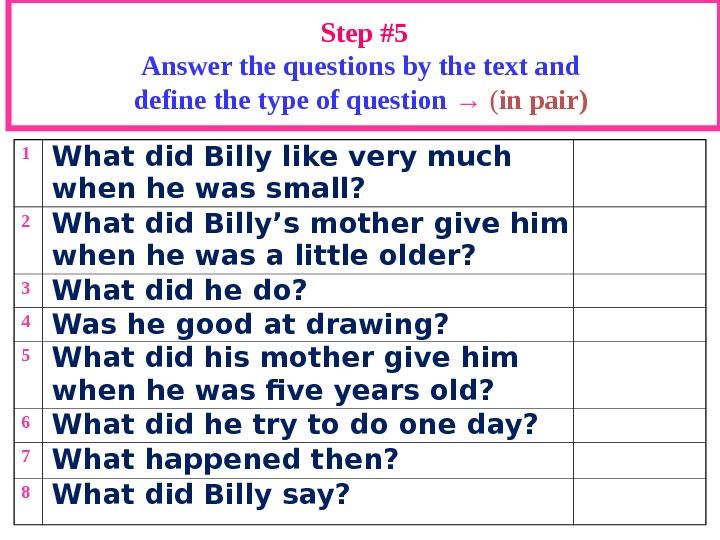
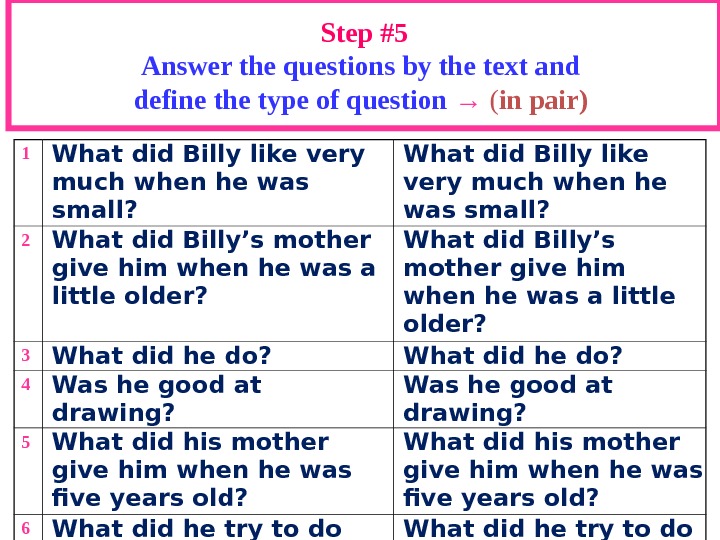
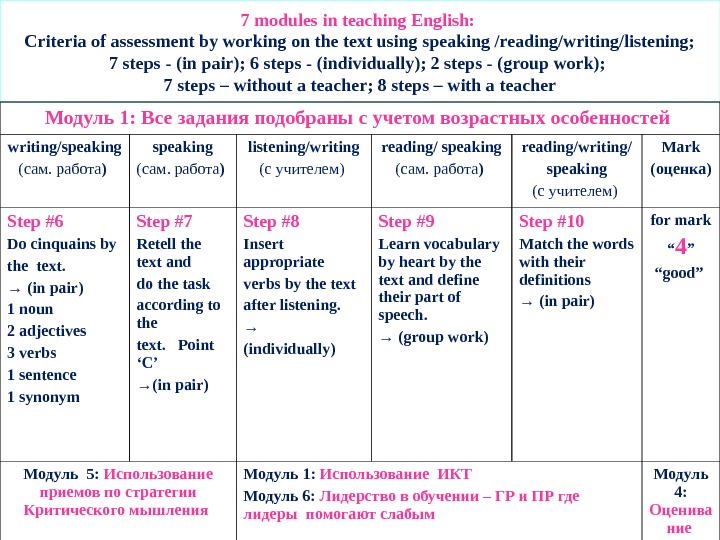
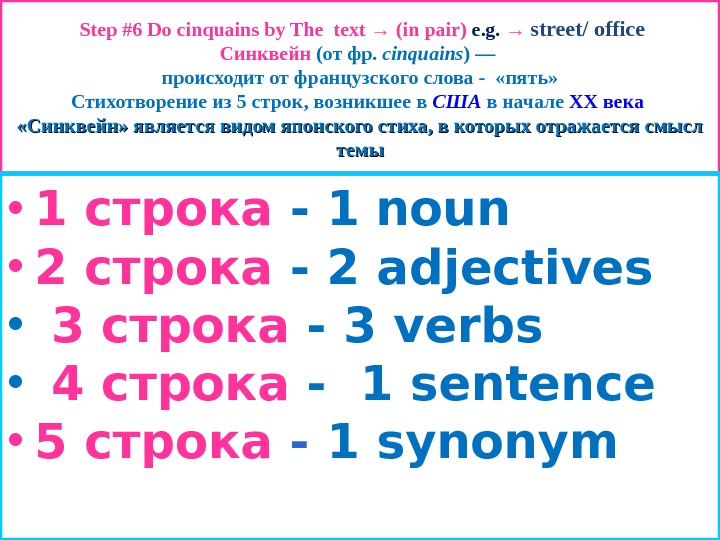

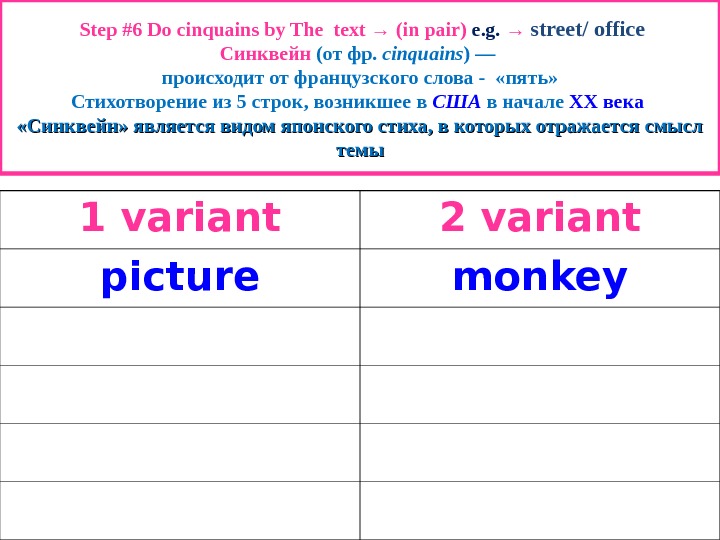
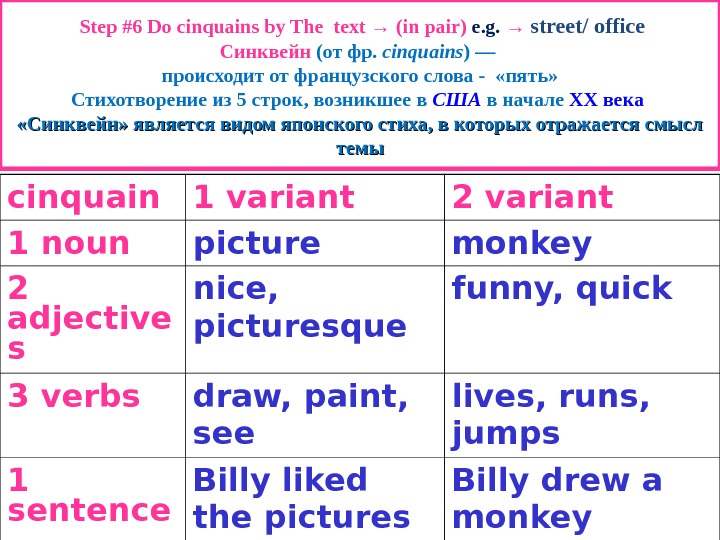
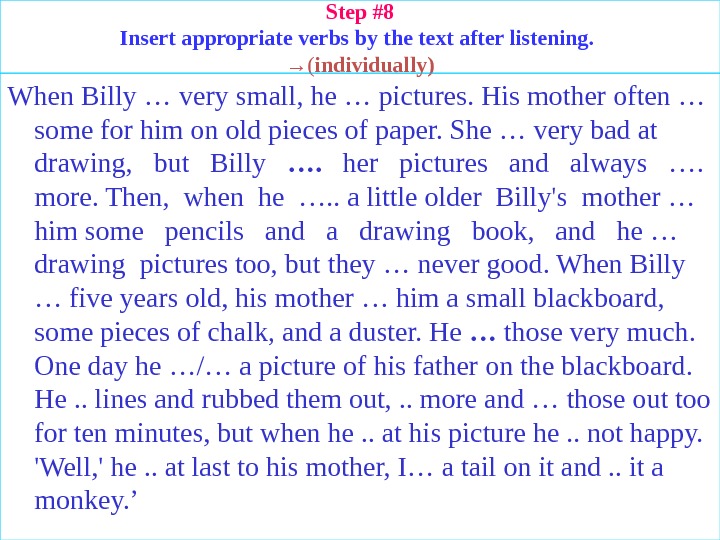


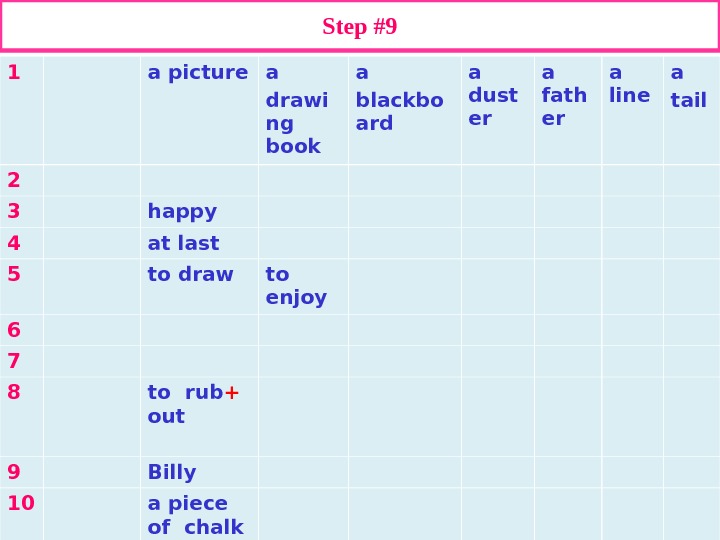
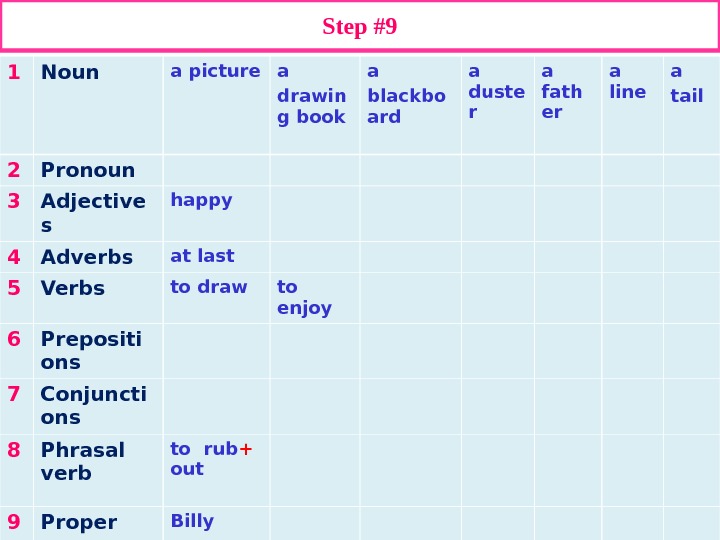

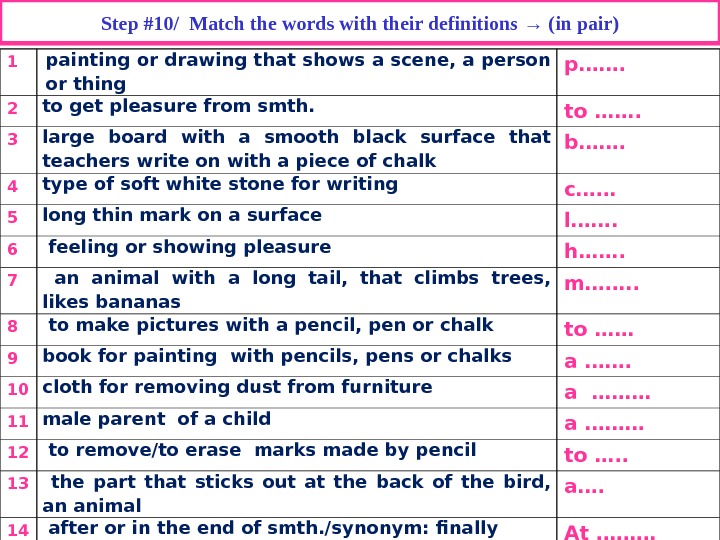
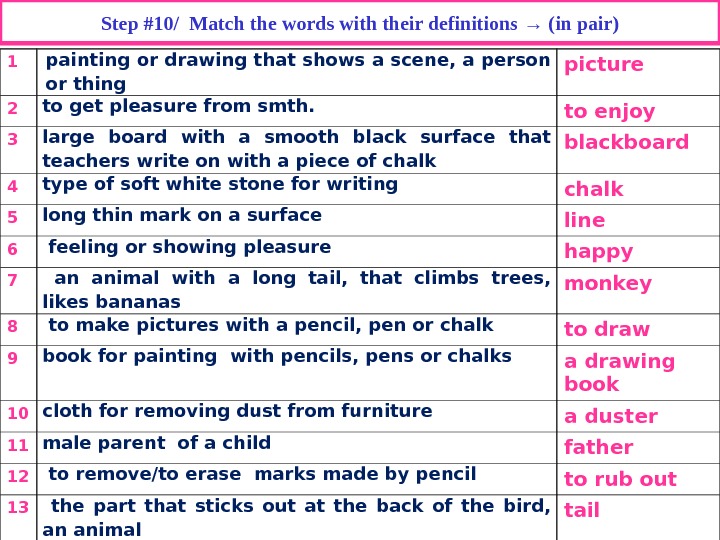
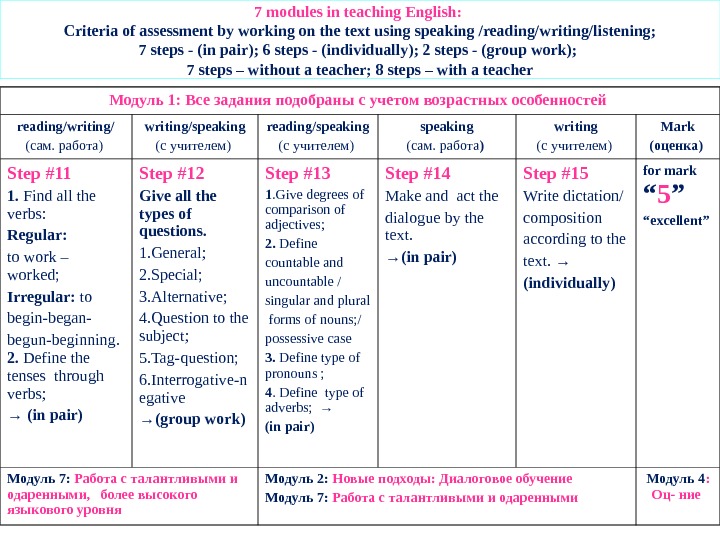
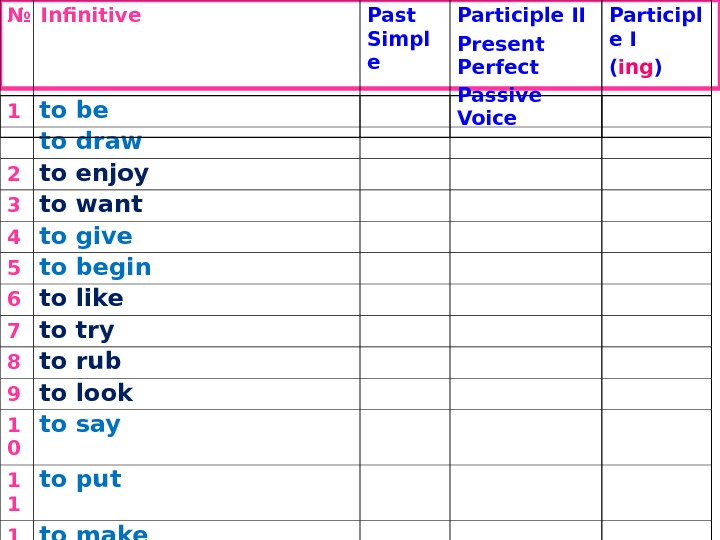
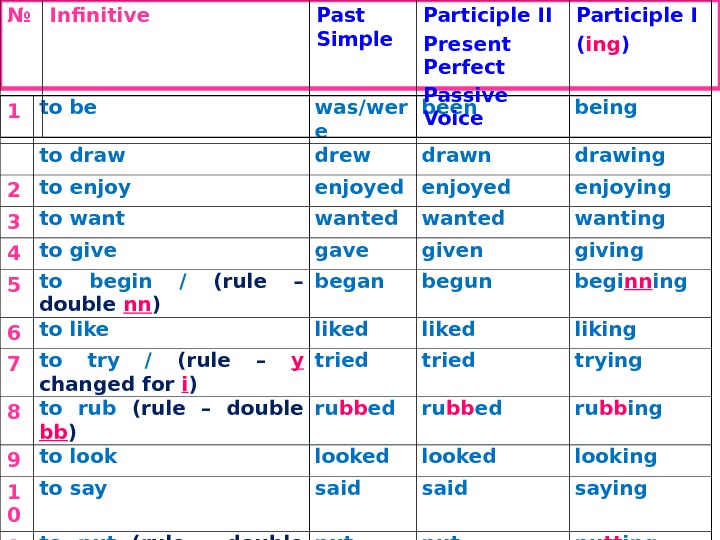
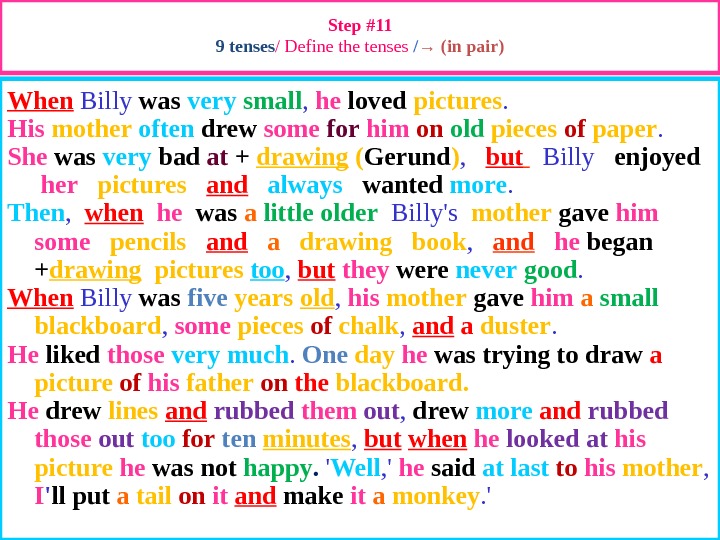


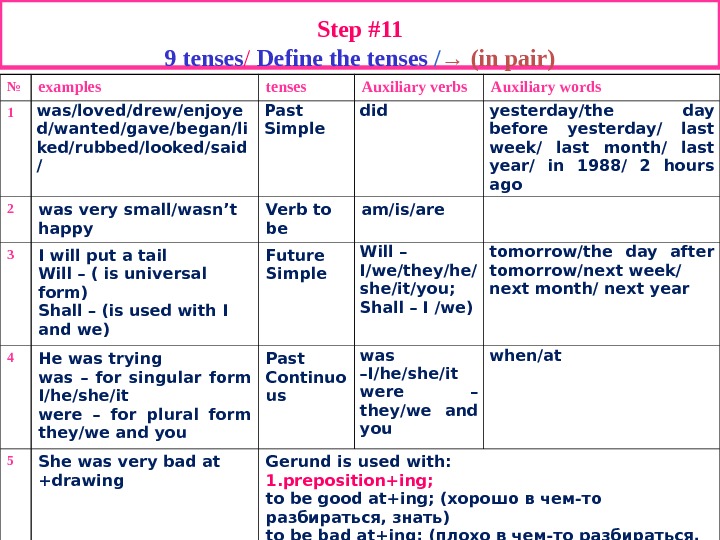


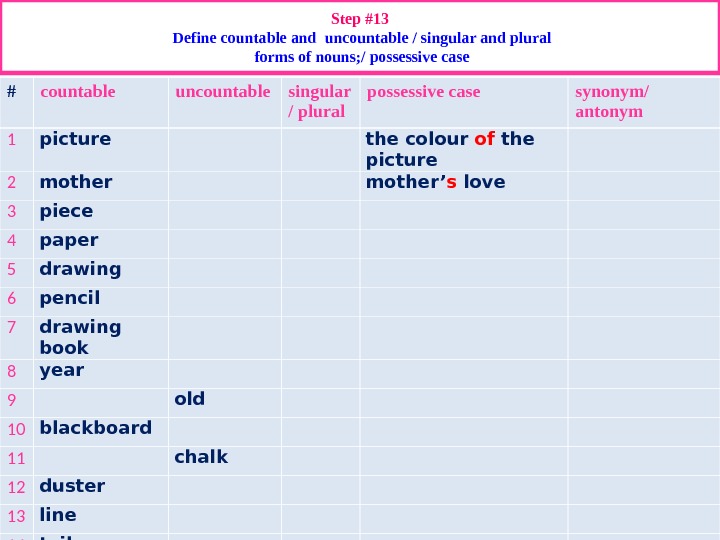
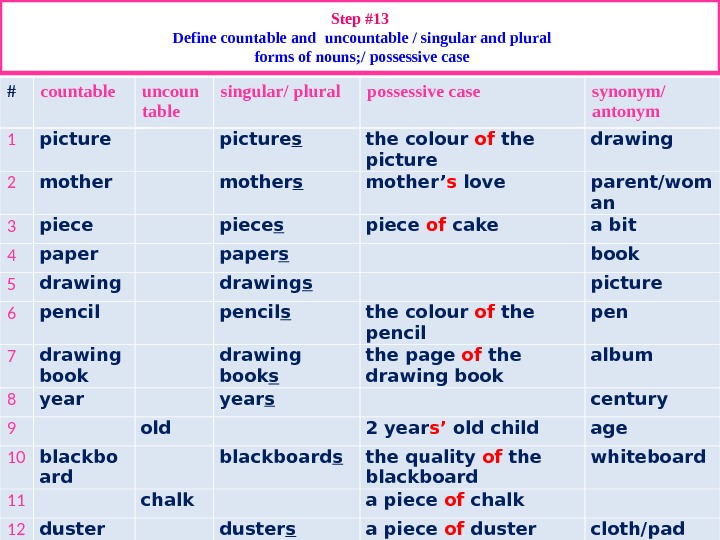
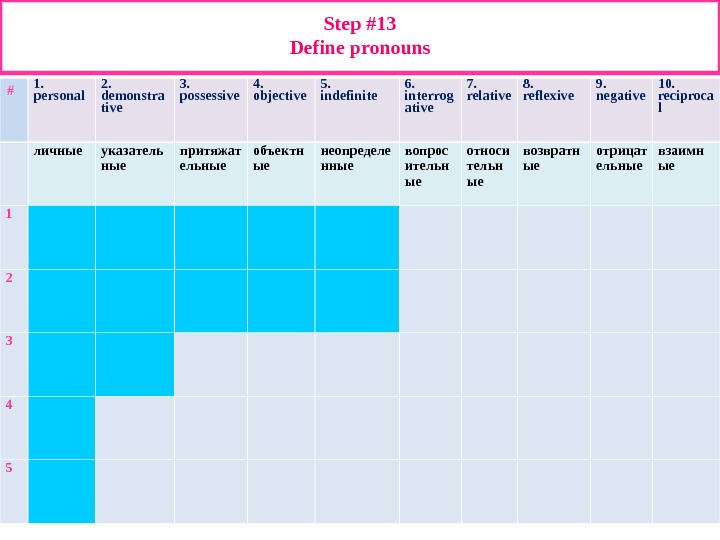
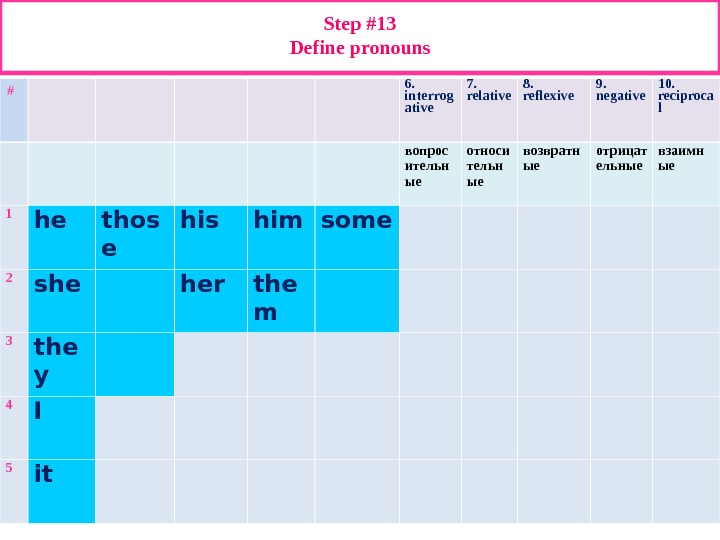
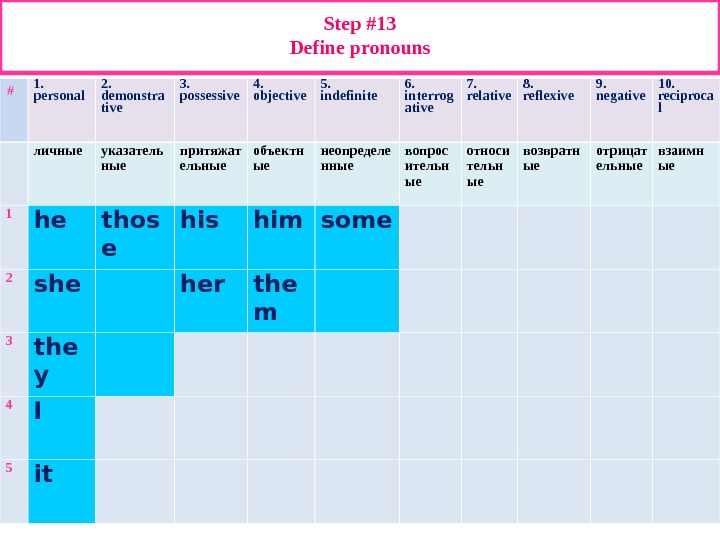
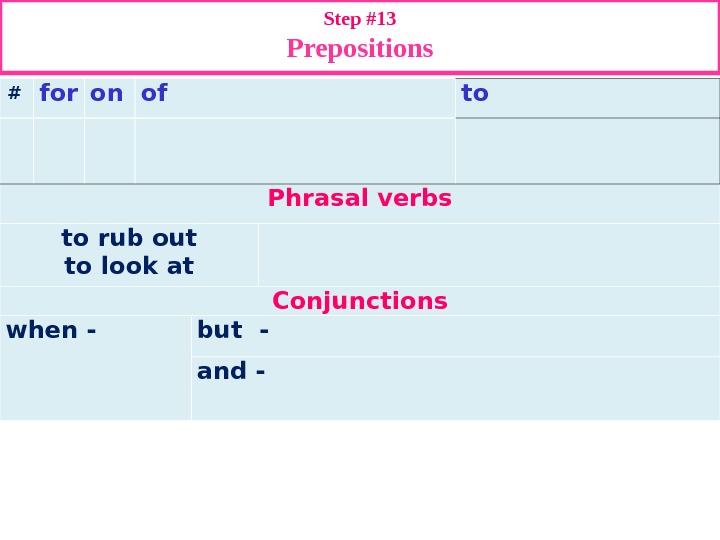

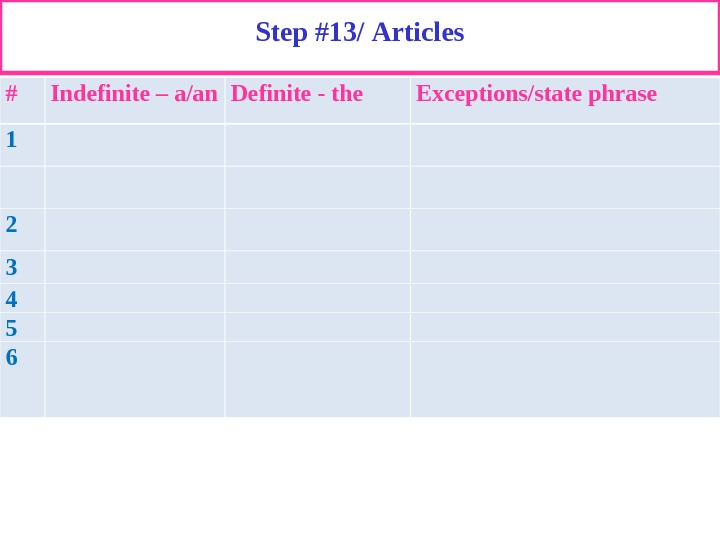

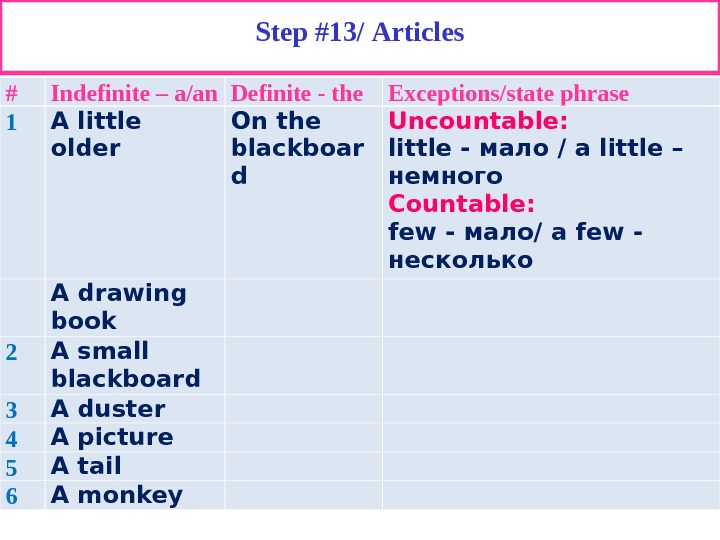
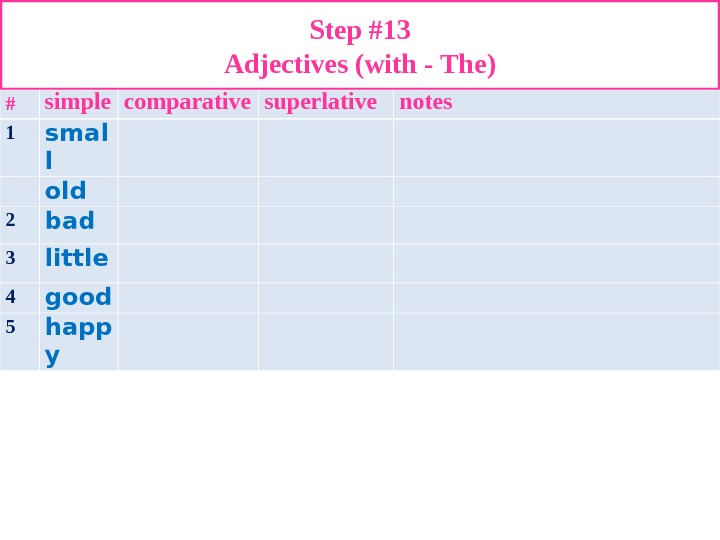
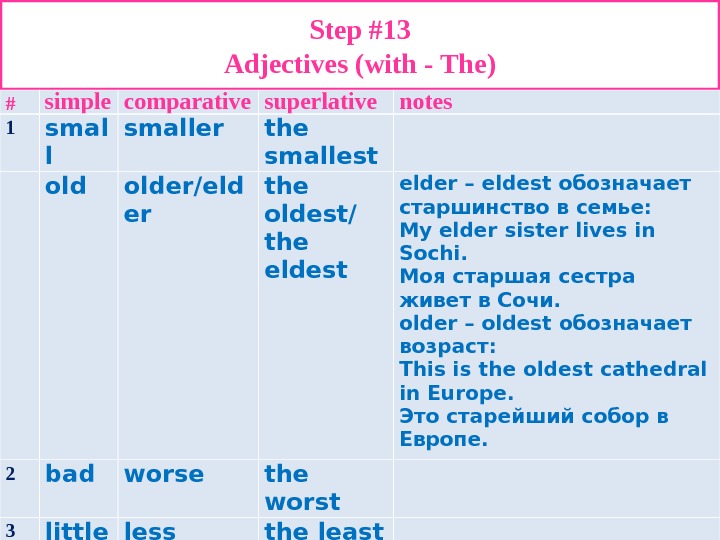
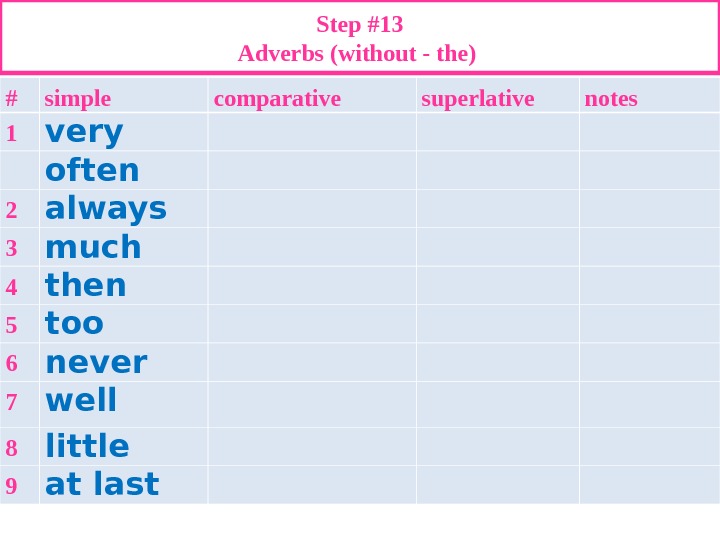

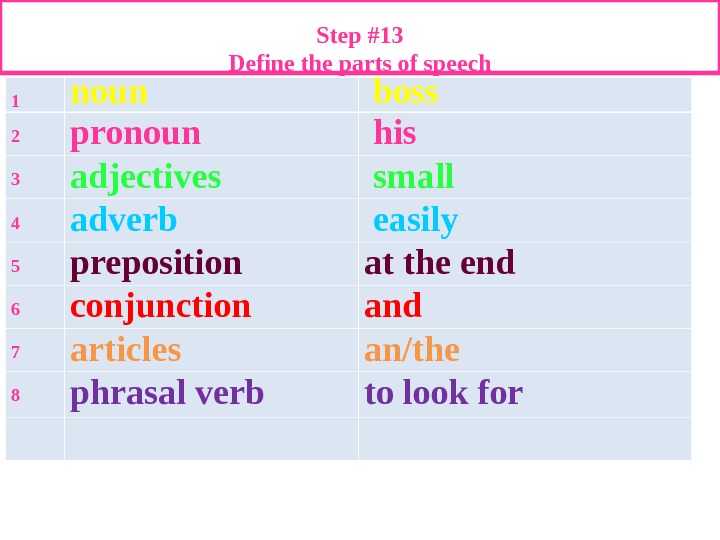
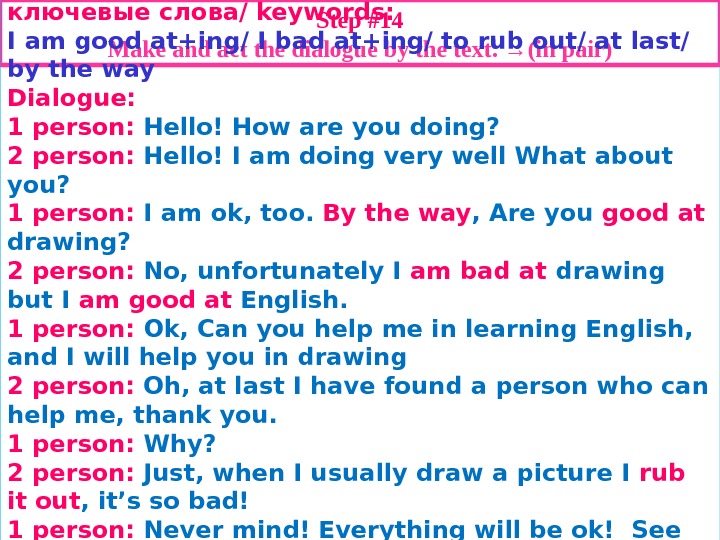
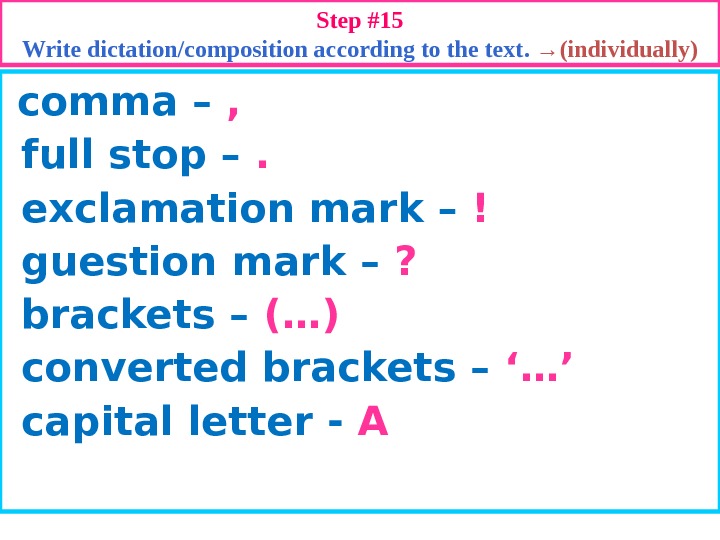
- Размер: 3.3 Mегабайта
- Количество слайдов: 58
Описание презентации Control work for the 3 term по слайдам
 Control work for the 3 term « 15 steps » 6 -7 grades
Control work for the 3 term « 15 steps » 6 -7 grades
 7 modules in teaching English: Criteria of assessment by working on the text using speaking / reading / writing / listening; 7 steps — ( in pair ); 6 steps — ( individually ); 2 steps — ( group work ); 7 steps – without a teacher ; 8 steps – with a teachercountable uncountable singular plural possessive case synonym/ant onym Модуль 1: Все задания подобраны с учетом возрастных особенностей speaking/listening (сам. работа ) listening (с учителем) reading (сам. работа ) reading/speaking (сам. работа ) Mark (оценка) Step #1 Describe the picture and headline the it → ( in pair) Step #2 Listen to the text and do the task: Guess, what is the difference between the picture and the text → (individually) Step #3 Read the text according to the picture, and do the task: 1. title; 2. plot; 3. conclusion → (individually) Step #4 Do the task: « True » or « False » by the text. → ( in pair ) Step #5 Answer the questions according to the text and define the type of question → ( in pair ) for mark “ 3 ” “ satisfied” Модуль 1 : Использование ИКТ/ Модуль 2: Новые подходы: Диалоговое обучение Модуль 3: Новые подходы: Работа с текстом с использованием вопросов по Таксономии Блума Модуль 4: Оценивани е 7 modules in teaching English: Criteria of assessment by working on the text using speaking / reading / writing / listening; 7 steps — (in pair); 6 steps — (individually); 2 steps — (group work); 7 steps – without a teacher; 8 steps – with a teacher
7 modules in teaching English: Criteria of assessment by working on the text using speaking / reading / writing / listening; 7 steps — ( in pair ); 6 steps — ( individually ); 2 steps — ( group work ); 7 steps – without a teacher ; 8 steps – with a teachercountable uncountable singular plural possessive case synonym/ant onym Модуль 1: Все задания подобраны с учетом возрастных особенностей speaking/listening (сам. работа ) listening (с учителем) reading (сам. работа ) reading/speaking (сам. работа ) Mark (оценка) Step #1 Describe the picture and headline the it → ( in pair) Step #2 Listen to the text and do the task: Guess, what is the difference between the picture and the text → (individually) Step #3 Read the text according to the picture, and do the task: 1. title; 2. plot; 3. conclusion → (individually) Step #4 Do the task: « True » or « False » by the text. → ( in pair ) Step #5 Answer the questions according to the text and define the type of question → ( in pair ) for mark “ 3 ” “ satisfied” Модуль 1 : Использование ИКТ/ Модуль 2: Новые подходы: Диалоговое обучение Модуль 3: Новые подходы: Работа с текстом с использованием вопросов по Таксономии Блума Модуль 4: Оценивани е 7 modules in teaching English: Criteria of assessment by working on the text using speaking / reading / writing / listening; 7 steps — (in pair); 6 steps — (individually); 2 steps — (group work); 7 steps – without a teacher; 8 steps – with a teacher
 Step #1 Describe the picture and headline it. (in pair)
Step #1 Describe the picture and headline it. (in pair)
 1 What can you see in this picture? I can see a small boy and maybe his mother. 2 Can you guess what they are doing? Judging by the picture I can guess they are talking about something interesting 3 Try to describe a small boy To my mind, this is a boy of about 4 or 5 years old. He is dressed in bright shoes and striped socks, shorts with suspenders and shirt with short sleeves. He has blond short hair. He is drawing something on the blackboard with a piece of chalk and is looking at his mom explaining something. He has nice eyes and a round face. . 4 What about his mother? Probably, She is about 30 or 35 years old. She is dressed in dark-colored trousers, high heel shoes and a jacket with a picture and short sleeves. She has long hair gathered at the back of her head. I can also see the earrings on her ears, her beautiful big eyes. She is looking at her son with love and attention. She is leaning forward and keeping both hands on her knees.
1 What can you see in this picture? I can see a small boy and maybe his mother. 2 Can you guess what they are doing? Judging by the picture I can guess they are talking about something interesting 3 Try to describe a small boy To my mind, this is a boy of about 4 or 5 years old. He is dressed in bright shoes and striped socks, shorts with suspenders and shirt with short sleeves. He has blond short hair. He is drawing something on the blackboard with a piece of chalk and is looking at his mom explaining something. He has nice eyes and a round face. . 4 What about his mother? Probably, She is about 30 or 35 years old. She is dressed in dark-colored trousers, high heel shoes and a jacket with a picture and short sleeves. She has long hair gathered at the back of her head. I can also see the earrings on her ears, her beautiful big eyes. She is looking at her son with love and attention. She is leaning forward and keeping both hands on her knees.
 5 Can you guess what this boy is drawing? It seems to me, he is drawing a monkey because I see long legs and long tail like the tail of the monkey. 6 What else can you see in this picture? I can also see the stand on the back of a blackboard. . 7 In conclusion what can you add? In conclusion I can add that this boy like s drawing and tries to draw more and more… 8 Can you give a title to this picture? I think , I can headline the picture as a …
5 Can you guess what this boy is drawing? It seems to me, he is drawing a monkey because I see long legs and long tail like the tail of the monkey. 6 What else can you see in this picture? I can also see the stand on the back of a blackboard. . 7 In conclusion what can you add? In conclusion I can add that this boy like s drawing and tries to draw more and more… 8 Can you give a title to this picture? I think , I can headline the picture as a …
 Step #13/ Define the parts of speech 1 noun yellow boss 2 pronoun pink his 3 adjectives green small 4 adverb light-blue easily 5 verbs black loved 6 prepositio n brown at the end 7 conjunctio n red and 8 articles orange an/the 9 phrasal verb violet to rub out 10 numerals grey ten 11 idioms blue at last 12 state phrase purple a piece of chalk
Step #13/ Define the parts of speech 1 noun yellow boss 2 pronoun pink his 3 adjectives green small 4 adverb light-blue easily 5 verbs black loved 6 prepositio n brown at the end 7 conjunctio n red and 8 articles orange an/the 9 phrasal verb violet to rub out 10 numerals grey ten 11 idioms blue at last 12 state phrase purple a piece of chalk
 Step #2/ Listen to the text and read the text by yourself: When Billy was very small , he loved pictures. His mother often drew some for him on old pieces of paper. She was very bad at + drawing ( Gerund ) , but Billy enjoyed her pictures and always wanted more. Then , when he was a little older Billy’s mother gave him some pencils and a drawing book , and he began + drawing pictures too , but they were never good. When Billy was five years old , his mother gave him a small blackboard , some pieces of chalk , and a duster. He liked those very much. One day he was trying to draw a picture of his father on the blackboard. He drew lines and rubbed them out , drew more and rubbed those out too for ten minutes , but when he looked at his picture he was not happy. ‘ Well , ‘ he said at last to his mother , I ‘ ll put a tail on it and make it a monkey. ‘
Step #2/ Listen to the text and read the text by yourself: When Billy was very small , he loved pictures. His mother often drew some for him on old pieces of paper. She was very bad at + drawing ( Gerund ) , but Billy enjoyed her pictures and always wanted more. Then , when he was a little older Billy’s mother gave him some pencils and a drawing book , and he began + drawing pictures too , but they were never good. When Billy was five years old , his mother gave him a small blackboard , some pieces of chalk , and a duster. He liked those very much. One day he was trying to draw a picture of his father on the blackboard. He drew lines and rubbed them out , drew more and rubbed those out too for ten minutes , but when he looked at his picture he was not happy. ‘ Well , ‘ he said at last to his mother , I ‘ ll put a tail on it and make it a monkey. ‘
 Step # 2 What is the difference between the picture and the text ? (individually) When Billy was very small , he loved pictures. His mother often drew some for him on old pieces of paper. She was very bad at drawing , but Billy enjoyed her pictures and always wanted more. Then, when he was a little older Billy’s mother gave him some pencils and a drawing book, and he began drawing pictures too, but they were never good. When Billy was five years old, his mother gave him a small blackboard, some pieces of chalk , and a duster. He liked those very much. One day he was trying to draw a picture of his father on the blackboard. He drew lines and rubbed them out, drew more and rubbed those out too for ten minutes, but when he looked at his picture he was not happy. ‘Well, ‘ he said at last to his mother, I’ll put a tail on it and make it a monkey. ’
Step # 2 What is the difference between the picture and the text ? (individually) When Billy was very small , he loved pictures. His mother often drew some for him on old pieces of paper. She was very bad at drawing , but Billy enjoyed her pictures and always wanted more. Then, when he was a little older Billy’s mother gave him some pencils and a drawing book, and he began drawing pictures too, but they were never good. When Billy was five years old, his mother gave him a small blackboard, some pieces of chalk , and a duster. He liked those very much. One day he was trying to draw a picture of his father on the blackboard. He drew lines and rubbed them out, drew more and rubbed those out too for ten minutes, but when he looked at his picture he was not happy. ‘Well, ‘ he said at last to his mother, I’ll put a tail on it and make it a monkey. ’
 Step # 2 What is the difference ? (individually) My opinion …………. . • The 1 st version – I believe , the picture and the text are similar • The 2 nd version – I suppose the picture and the text are quite different • I have chosen the 3 rd version – I consider, the picture is a bit different in comparison with the text, because …….
Step # 2 What is the difference ? (individually) My opinion …………. . • The 1 st version – I believe , the picture and the text are similar • The 2 nd version – I suppose the picture and the text are quite different • I have chosen the 3 rd version – I consider, the picture is a bit different in comparison with the text, because …….
 Step # 2 What is the difference ? (individually) My opinion …………. . The 1 st version – I assume , the picture and the text are similar The 2 nd version – I presume the picture and the text are quite different I have chosen the 3 rd version – I consider that the picture is a bit different in comparison with the text, because judging by the picture I can’t guess that Billy was trying to draw a picture of his father, I suppose he is drawing a monkey.
Step # 2 What is the difference ? (individually) My opinion …………. . The 1 st version – I assume , the picture and the text are similar The 2 nd version – I presume the picture and the text are quite different I have chosen the 3 rd version – I consider that the picture is a bit different in comparison with the text, because judging by the picture I can’t guess that Billy was trying to draw a picture of his father, I suppose he is drawing a monkey.
 Summary: I think … I assume, I presume, I believe, I suppose , T o my mind , In my opinion , F rom my point of view, I consider, As far as I understood, Judging by the picture, In conclusion , Finally/At last, to summarize, Therefore
Summary: I think … I assume, I presume, I believe, I suppose , T o my mind , In my opinion , F rom my point of view, I consider, As far as I understood, Judging by the picture, In conclusion , Finally/At last, to summarize, Therefore
 Summary Parenthesis: 1 I assume Я думаю 2 I presume 3 I believe 4 I suppose Я полагаю 5 In my view С моей точки зрения 6 To my mind По-моему 7 In my opinion 8 From my point of view С моей точки зрения 9 I consider Я считаю
Summary Parenthesis: 1 I assume Я думаю 2 I presume 3 I believe 4 I suppose Я полагаю 5 In my view С моей точки зрения 6 To my mind По-моему 7 In my opinion 8 From my point of view С моей точки зрения 9 I consider Я считаю
 Summary Conclusion: 1 In conclusion В заключение 2 Finally/at last И наконец 3 To summarize Таким образом 4 Therefore Следовательно
Summary Conclusion: 1 In conclusion В заключение 2 Finally/at last И наконец 3 To summarize Таким образом 4 Therefore Следовательно
 Step #3 Read the text by the picture, and do the task: 1. title; 2. plot; 3. conclusion → (individually) 1. Title: Title of the text is… 2. Plot: To my mind, ………. 3. Conclusion: At last.
Step #3 Read the text by the picture, and do the task: 1. title; 2. plot; 3. conclusion → (individually) 1. Title: Title of the text is… 2. Plot: To my mind, ………. 3. Conclusion: At last.
 Step #3 Read the text by the picture, and do the task: 1. title; 2. plot; 3. conclusion → (individually) 1. Title: A future artist 2. Plot: I suppose this text is about a small boy called Billy who couldn’t draw the picture but he was trying more and more. 3. Conclusion : At last , he drew a monkey instead of his father what is very amusing.
Step #3 Read the text by the picture, and do the task: 1. title; 2. plot; 3. conclusion → (individually) 1. Title: A future artist 2. Plot: I suppose this text is about a small boy called Billy who couldn’t draw the picture but he was trying more and more. 3. Conclusion : At last , he drew a monkey instead of his father what is very amusing.
 Step # 4 Do the task: « True » or « False » ( in pair ) 1 Billy’s mother often drew pictures for him 2 She was very good at drawing 3 Billy’s drawings were not very good. 4 Billy liked his blackboard very much 5 Billy drew a good picture of his father 6 Billy drew a good picture of a monkey
Step # 4 Do the task: « True » or « False » ( in pair ) 1 Billy’s mother often drew pictures for him 2 She was very good at drawing 3 Billy’s drawings were not very good. 4 Billy liked his blackboard very much 5 Billy drew a good picture of his father 6 Billy drew a good picture of a monkey
 Step # 4 Do the task: « True » or « False » ( in pair ) 1 Billy’s mother often drew pictures for him true 2 She was very good at drawing fals e 3 Billy’s drawings were not very good. true 4 Billy liked his blackboard very much true 5 Billy drew a good picture of his father fals e 6 Billy drew a good picture of a monkey true
Step # 4 Do the task: « True » or « False » ( in pair ) 1 Billy’s mother often drew pictures for him true 2 She was very good at drawing fals e 3 Billy’s drawings were not very good. true 4 Billy liked his blackboard very much true 5 Billy drew a good picture of his father fals e 6 Billy drew a good picture of a monkey true
 Step #5 Answer the questions by the text and define the type of question → ( in pair ) 1 What did Billy like very much when he was small? 2 What did Billy’s mother give him when he was a little older? 3 What did he do? 4 Was he good at drawing? 5 What did his mother give him when he was five years old? 6 What did he try to do one day? 7 What happened then? 8 What did Billy say?
Step #5 Answer the questions by the text and define the type of question → ( in pair ) 1 What did Billy like very much when he was small? 2 What did Billy’s mother give him when he was a little older? 3 What did he do? 4 Was he good at drawing? 5 What did his mother give him when he was five years old? 6 What did he try to do one day? 7 What happened then? 8 What did Billy say?
 Step #5 Answer the questions by the text and define the type of question → ( in pair ) 1 What did Billy like very much when he was small? 2 What did Billy’s mother give him when he was a little older? 3 What did he do? 4 Was he good at drawing? 5 What did his mother give him when he was five years old? 6 What did he try to do one day? 7 What happened then? 8 What did Billy say?
Step #5 Answer the questions by the text and define the type of question → ( in pair ) 1 What did Billy like very much when he was small? 2 What did Billy’s mother give him when he was a little older? 3 What did he do? 4 Was he good at drawing? 5 What did his mother give him when he was five years old? 6 What did he try to do one day? 7 What happened then? 8 What did Billy say?
 7 modules in teaching English: Criteria of assessment by working on the text using speaking /reading/writing/listening; 7 steps — (in pair); 6 steps — (individually); 2 steps — (group work); 7 steps – without a teacher; 8 steps – with a teacher Модуль 1: Все задания подобраны с учетом возрастных особенностей writing/speaking (сам. работа ) listening/writing (с учителем) reading/ speaking (сам. работа ) reading/writing/ speaking (с учителем) Mark (оценка) Step #6 Do cinquain s by the text. → ( in pair ) 1 noun 2 adjectives 3 verbs 1 sentence 1 synonym Step #7 Retell the text and do the task according to the text. Point ‘C’ → (in pair) Step #8 Insert appropriate verbs by the text after listening. → ( individually ) Step #9 Learn vocabulary by heart by the text and define their part of speech. → (group work) Step #10 Match the words with their definitions → ( in pair ) for mark “ 4 ” “ good” Модуль 5: Использование приемов по стратегии Критического мышления Модуль 1 : Использование ИКТ Модуль 6: Лидерство в обучении – ГР и ПР где лидеры помогают слабым Модуль 4 : Оценива ние
7 modules in teaching English: Criteria of assessment by working on the text using speaking /reading/writing/listening; 7 steps — (in pair); 6 steps — (individually); 2 steps — (group work); 7 steps – without a teacher; 8 steps – with a teacher Модуль 1: Все задания подобраны с учетом возрастных особенностей writing/speaking (сам. работа ) listening/writing (с учителем) reading/ speaking (сам. работа ) reading/writing/ speaking (с учителем) Mark (оценка) Step #6 Do cinquain s by the text. → ( in pair ) 1 noun 2 adjectives 3 verbs 1 sentence 1 synonym Step #7 Retell the text and do the task according to the text. Point ‘C’ → (in pair) Step #8 Insert appropriate verbs by the text after listening. → ( individually ) Step #9 Learn vocabulary by heart by the text and define their part of speech. → (group work) Step #10 Match the words with their definitions → ( in pair ) for mark “ 4 ” “ good” Модуль 5: Использование приемов по стратегии Критического мышления Модуль 1 : Использование ИКТ Модуль 6: Лидерство в обучении – ГР и ПР где лидеры помогают слабым Модуль 4 : Оценива ние
 Step #6 Do cinquain s by The text → ( in pair ) e. g. → street/ office Синквейн (от фр. cinquains ) — происходит от французского слова — «пять» Стихотворение из 5 строк, возникшее в США в начале XX века «Синквейн» является видом японского стиха, в которых отражается смысл темы • 1 строка — 1 noun • 2 строка — 2 adjectives • 3 строка — 3 verbs • 4 строка — 1 sentence • 5 строка — 1 synonym
Step #6 Do cinquain s by The text → ( in pair ) e. g. → street/ office Синквейн (от фр. cinquains ) — происходит от французского слова — «пять» Стихотворение из 5 строк, возникшее в США в начале XX века «Синквейн» является видом японского стиха, в которых отражается смысл темы • 1 строка — 1 noun • 2 строка — 2 adjectives • 3 строка — 3 verbs • 4 строка — 1 sentence • 5 строка — 1 synonym
 Step #6 Make C luster by Phonetics and Rules of reading Phoneti cs 1. m o ther l o ved m o nkey s o me m/n/v/th 4. ch al k 5. sm all 2. dr aw i ng 3. men tion ed 6. to r u b out
Step #6 Make C luster by Phonetics and Rules of reading Phoneti cs 1. m o ther l o ved m o nkey s o me m/n/v/th 4. ch al k 5. sm all 2. dr aw i ng 3. men tion ed 6. to r u b out
 Step #6 Do cinquain s by The text → ( in pair ) e. g. → street/ office Синквейн (от фр. cinquains ) — происходит от французского слова — «пять» Стихотворение из 5 строк, возникшее в США в начале XX века «Синквейн» является видом японского стиха, в которых отражается смысл темы 1 variant 2 variant picture monkey
Step #6 Do cinquain s by The text → ( in pair ) e. g. → street/ office Синквейн (от фр. cinquains ) — происходит от французского слова — «пять» Стихотворение из 5 строк, возникшее в США в начале XX века «Синквейн» является видом японского стиха, в которых отражается смысл темы 1 variant 2 variant picture monkey
 Step #6 Do cinquain s by The text → ( in pair ) e. g. → street/ office Синквейн (от фр. cinquains ) — происходит от французского слова — «пять» Стихотворение из 5 строк, возникшее в США в начале XX века «Синквейн» является видом японского стиха, в которых отражается смысл темы cinquain 1 variant 2 variant 1 noun picture monkey 2 adjective s nice, picturesque funny, quick 3 verbs draw, paint, see lives, runs, jumps 1 sentence Billy liked the pictures Billy drew a monkey instead of his father 1 synonym art animal
Step #6 Do cinquain s by The text → ( in pair ) e. g. → street/ office Синквейн (от фр. cinquains ) — происходит от французского слова — «пять» Стихотворение из 5 строк, возникшее в США в начале XX века «Синквейн» является видом японского стиха, в которых отражается смысл темы cinquain 1 variant 2 variant 1 noun picture monkey 2 adjective s nice, picturesque funny, quick 3 verbs draw, paint, see lives, runs, jumps 1 sentence Billy liked the pictures Billy drew a monkey instead of his father 1 synonym art animal
 Step #8 Insert appropriate verbs by the text after listening. → ( individually ) When Billy … very small, he … pictures. His mother often … some for him on old pieces of paper. She … very bad at drawing, but Billy …. her pictures and always …. more. Then, when he …. . a little older Billy’s mother … him some pencils and a drawing book, and he … drawing pictures too, but they … never good. When Billy … five years old, his mother … him a small blackboard, some pieces of chalk, and a duster. He … those very much. One day he …/… a picture of his father on the blackboard. He. . lines and rubbed them out, . . more and … those out too for ten minutes, but when he. . at his picture he. . not happy. ‘Well, ‘ he. . at last to his mother, I… a tail on it and. . it a monkey. ’
Step #8 Insert appropriate verbs by the text after listening. → ( individually ) When Billy … very small, he … pictures. His mother often … some for him on old pieces of paper. She … very bad at drawing, but Billy …. her pictures and always …. more. Then, when he …. . a little older Billy’s mother … him some pencils and a drawing book, and he … drawing pictures too, but they … never good. When Billy … five years old, his mother … him a small blackboard, some pieces of chalk, and a duster. He … those very much. One day he …/… a picture of his father on the blackboard. He. . lines and rubbed them out, . . more and … those out too for ten minutes, but when he. . at his picture he. . not happy. ‘Well, ‘ he. . at last to his mother, I… a tail on it and. . it a monkey. ’
 Step #9 Learn vocabulary by heart by the text and define their part of speech. → (group work) 1. ……… – картина 2. ………. – рисовать 3. ………. . – наслаждаться 4. …………. — альбом для рисования 5. . . – доска 6. ………. – тряпка 7. ………. . — кусок мела 8. …… – папа 9. . – линия 10. ……. . – стирать 11. ……. – счастливый 12. …… – хвост 13. ……. – обезьяна 14. ………. — наконец
Step #9 Learn vocabulary by heart by the text and define their part of speech. → (group work) 1. ……… – картина 2. ………. – рисовать 3. ………. . – наслаждаться 4. …………. — альбом для рисования 5. . . – доска 6. ………. – тряпка 7. ………. . — кусок мела 8. …… – папа 9. . – линия 10. ……. . – стирать 11. ……. – счастливый 12. …… – хвост 13. ……. – обезьяна 14. ………. — наконец
 Step #9 Learn vocabulary by heart by the text and define their part of speech. → (group work) 1. picture – картина 2. to draw – рисовать 3. to enjoy – наслаждаться 4. a drawing book — альбом для рисования 5. a blackboard – доска 6. a duster – тряпка 7. a piece of chalk — кусок мела 8. father – папа 9. a l ine – линия 10. to rub – стирать 11. happy – счастливый 12. a tail – хвост 13. a monkey – обезьяна 14. at last — наконец
Step #9 Learn vocabulary by heart by the text and define their part of speech. → (group work) 1. picture – картина 2. to draw – рисовать 3. to enjoy – наслаждаться 4. a drawing book — альбом для рисования 5. a blackboard – доска 6. a duster – тряпка 7. a piece of chalk — кусок мела 8. father – папа 9. a l ine – линия 10. to rub – стирать 11. happy – счастливый 12. a tail – хвост 13. a monkey – обезьяна 14. at last — наконец
 Step #9 1 a picture a drawi ng book a blackbo ard a dust er a fath er a l ine a tail 2 3 happy 4 at last 5 to draw to enjoy 6 7 8 to rub + out 9 Billy 10 a piece of chalk
Step #9 1 a picture a drawi ng book a blackbo ard a dust er a fath er a l ine a tail 2 3 happy 4 at last 5 to draw to enjoy 6 7 8 to rub + out 9 Billy 10 a piece of chalk
 Step #9 1 Noun a picture a drawin g book a blackbo ard a duste r a fath er a l ine a tail 2 Pronoun 3 Adjective s happy 4 Adverbs at last 5 Verbs to draw to enjoy 6 Prepositi ons 7 Conjuncti ons 8 Phrasal verb to rub + out 9 Proper name Billy 1 0 State phrase a piece of chalk
Step #9 1 Noun a picture a drawin g book a blackbo ard a duste r a fath er a l ine a tail 2 Pronoun 3 Adjective s happy 4 Adverbs at last 5 Verbs to draw to enjoy 6 Prepositi ons 7 Conjuncti ons 8 Phrasal verb to rub + out 9 Proper name Billy 1 0 State phrase a piece of chalk
 Step #10/ Match the words with their definitions → ( in pair ) 1 painting or drawing that shows a scene, a person or thing 2 to get pleasure from smth. 3 large board with a smooth black surface that teachers write on with a piece of chalk 4 type of soft white stone for writing 5 long thin mark on a surface 6 feeling or showing pleasure 7 an animal with a long tail, that climbs trees, likes bananas 8 to make pictures with a pencil, pen or chalk 9 book for painting with pencils, pens or chalks 10 cloth for removing dust from furniture 11 male parent of a child 12 to remove/to erase marks made by pencil 13 the part that sticks out at the back of the bird, an animal 14 after or in the end of smth. /synonym: finally
Step #10/ Match the words with their definitions → ( in pair ) 1 painting or drawing that shows a scene, a person or thing 2 to get pleasure from smth. 3 large board with a smooth black surface that teachers write on with a piece of chalk 4 type of soft white stone for writing 5 long thin mark on a surface 6 feeling or showing pleasure 7 an animal with a long tail, that climbs trees, likes bananas 8 to make pictures with a pencil, pen or chalk 9 book for painting with pencils, pens or chalks 10 cloth for removing dust from furniture 11 male parent of a child 12 to remove/to erase marks made by pencil 13 the part that sticks out at the back of the bird, an animal 14 after or in the end of smth. /synonym: finally
 Step #10/ Match the words with their definitions → ( in pair ) 1 painting or drawing that shows a scene, a person or thing p……. 2 to get pleasure from smth. to ……. 3 large board with a smooth black surface that teachers write on with a piece of chalk b……. 4 type of soft white stone for writing c…… 5 long thin mark on a surface l……. 6 feeling or showing pleasure h……. 7 an animal with a long tail, that climbs trees, likes bananas m……. . 8 to make pictures with a pencil, pen or chalk to …… 9 book for painting with pencils, pens or chalks a ……. 10 cloth for removing dust from furniture a ……… 11 male parent of a child a ……… 12 to remove/to erase marks made by pencil to …. . 13 the part that sticks out at the back of the bird, an animal a…. 14 after or in the end of smth. /synonym: finally At ………
Step #10/ Match the words with their definitions → ( in pair ) 1 painting or drawing that shows a scene, a person or thing p……. 2 to get pleasure from smth. to ……. 3 large board with a smooth black surface that teachers write on with a piece of chalk b……. 4 type of soft white stone for writing c…… 5 long thin mark on a surface l……. 6 feeling or showing pleasure h……. 7 an animal with a long tail, that climbs trees, likes bananas m……. . 8 to make pictures with a pencil, pen or chalk to …… 9 book for painting with pencils, pens or chalks a ……. 10 cloth for removing dust from furniture a ……… 11 male parent of a child a ……… 12 to remove/to erase marks made by pencil to …. . 13 the part that sticks out at the back of the bird, an animal a…. 14 after or in the end of smth. /synonym: finally At ………
 Step #10/ Match the words with their definitions → ( in pair ) 1 painting or drawing that shows a scene, a person or thing picture 2 to get pleasure from smth. to enjoy 3 large board with a smooth black surface that teachers write on with a piece of chalk blackboard 4 type of soft white stone for writing chalk 5 long thin mark on a surface line 6 feeling or showing pleasure happy 7 an animal with a long tail, that climbs trees, likes bananas monkey 8 to make pictures with a pencil, pen or chalk to draw 9 book for painting with pencils, pens or chalks a drawing book 10 cloth for removing dust from furniture a duster 11 male parent of a child father 12 to remove/to erase marks made by pencil to rub out 13 the part that sticks out at the back of the bird, an animal tail 14 after or in the end of smth. /synonym: finally At last
Step #10/ Match the words with their definitions → ( in pair ) 1 painting or drawing that shows a scene, a person or thing picture 2 to get pleasure from smth. to enjoy 3 large board with a smooth black surface that teachers write on with a piece of chalk blackboard 4 type of soft white stone for writing chalk 5 long thin mark on a surface line 6 feeling or showing pleasure happy 7 an animal with a long tail, that climbs trees, likes bananas monkey 8 to make pictures with a pencil, pen or chalk to draw 9 book for painting with pencils, pens or chalks a drawing book 10 cloth for removing dust from furniture a duster 11 male parent of a child father 12 to remove/to erase marks made by pencil to rub out 13 the part that sticks out at the back of the bird, an animal tail 14 after or in the end of smth. /synonym: finally At last
 7 modules in teaching English: Criteria of assessment by working on the text using speaking /reading/writing/listening; 7 steps — (in pair); 6 steps — (individually); 2 steps — (group work); 7 steps – without a teacher; 8 steps – with a teacher Модуль 1: Все задания подобраны с учетом возрастных особенностей reading/writing/ ( сам. работа ) writing/speaking (с учителем) reading/speaking (с учителем) speaking (сам. работа ) writing (с учителем) Mark (оценка) Step #11 1. Find all the verbs: Regular: to work – worked; Irregular : to begin — began — begun — beginning. 2. Define the tenses through verbs; → (in pair) Step #12 Give all the types of questions. 1. General; 2. Special; 3. Alternative; 4. Question to the subject; 5. Tag-question; 6. Interrogative-n egative → (group work) Step #13 1. Give degrees of comparison of adjectives; 2. Define countable and uncountable / singular and plural forms of nouns; / possessive case 3. Define type of pronouns ; 4. Define type of adverbs; → (in pair) Step #14 Make and act the dialogue by the text. → (in pair) Step #15 Write dictation/ composition according to the text. → (individually) for mark “ 5 ” “ excellent” Модуль 7: Работа с талантливыми и одаренными, более высокого языкового уровня Модуль 2: Новые подходы: Диалоговое обучение Модуль 7: Работа с талантливыми и одаренными Модуль 4 : Оц — ние
7 modules in teaching English: Criteria of assessment by working on the text using speaking /reading/writing/listening; 7 steps — (in pair); 6 steps — (individually); 2 steps — (group work); 7 steps – without a teacher; 8 steps – with a teacher Модуль 1: Все задания подобраны с учетом возрастных особенностей reading/writing/ ( сам. работа ) writing/speaking (с учителем) reading/speaking (с учителем) speaking (сам. работа ) writing (с учителем) Mark (оценка) Step #11 1. Find all the verbs: Regular: to work – worked; Irregular : to begin — began — begun — beginning. 2. Define the tenses through verbs; → (in pair) Step #12 Give all the types of questions. 1. General; 2. Special; 3. Alternative; 4. Question to the subject; 5. Tag-question; 6. Interrogative-n egative → (group work) Step #13 1. Give degrees of comparison of adjectives; 2. Define countable and uncountable / singular and plural forms of nouns; / possessive case 3. Define type of pronouns ; 4. Define type of adverbs; → (in pair) Step #14 Make and act the dialogue by the text. → (in pair) Step #15 Write dictation/ composition according to the text. → (individually) for mark “ 5 ” “ excellent” Модуль 7: Работа с талантливыми и одаренными, более высокого языкового уровня Модуль 2: Новые подходы: Диалоговое обучение Модуль 7: Работа с талантливыми и одаренными Модуль 4 : Оц — ние
 1 to be to draw 2 to enjoy 3 to want 4 to give 5 to begin 6 to like 7 to try 8 to rub 9 to look 1 0 to say 1 1 to put 1 2 to make№ Infinitive Past Simpl e Participle II Present Perfect Passive Voice Participl e I ( ing )
1 to be to draw 2 to enjoy 3 to want 4 to give 5 to begin 6 to like 7 to try 8 to rub 9 to look 1 0 to say 1 1 to put 1 2 to make№ Infinitive Past Simpl e Participle II Present Perfect Passive Voice Participl e I ( ing )
 1 to be was/wer e been being to draw drew drawn drawing 2 to enjoyed enjoying 3 to wanted wanting 4 to give gave given giving 5 to begin / (rule – double nn ) began begun begi nn ing 6 to liked liking 7 to try / (rule – y changed for i ) tried trying 8 to rub (rule – double bb ) ru bb ed ru bb ing 9 to looked looking 1 0 to say said saying 1 1 to put (rule – double tt ) put pu tt ing 1 2 to make made making№ Infinitive Past Simple Participle II Present Perfect Passive Voice Participle I ( ing )
1 to be was/wer e been being to draw drew drawn drawing 2 to enjoyed enjoying 3 to wanted wanting 4 to give gave given giving 5 to begin / (rule – double nn ) began begun begi nn ing 6 to liked liking 7 to try / (rule – y changed for i ) tried trying 8 to rub (rule – double bb ) ru bb ed ru bb ing 9 to looked looking 1 0 to say said saying 1 1 to put (rule – double tt ) put pu tt ing 1 2 to make made making№ Infinitive Past Simple Participle II Present Perfect Passive Voice Participle I ( ing )
 Step #11 9 tenses / Define the tenses / → (in pair) When Billy was very small , he loved pictures. His mother often drew some for him on old pieces of paper. She was very bad at + drawing ( Gerund ) , but Billy enjoyed her pictures and always wanted more. Then , when he was a little older Billy’s mother gave him some pencils and a drawing book , and he began + drawing pictures too , but they were never good. When Billy was five years old , his mother gave him a small blackboard , some pieces of chalk , and a duster. He liked those very much. One day he was trying to draw a picture of his father on the blackboard. He drew lines and rubbed them out , drew more and rubbed those out too for ten minutes , but when he looked at his picture he was not happy. ‘ Well , ‘ he said at last to his mother , I ‘ ll put a tail on it and make it a monkey. ‘
Step #11 9 tenses / Define the tenses / → (in pair) When Billy was very small , he loved pictures. His mother often drew some for him on old pieces of paper. She was very bad at + drawing ( Gerund ) , but Billy enjoyed her pictures and always wanted more. Then , when he was a little older Billy’s mother gave him some pencils and a drawing book , and he began + drawing pictures too , but they were never good. When Billy was five years old , his mother gave him a small blackboard , some pieces of chalk , and a duster. He liked those very much. One day he was trying to draw a picture of his father on the blackboard. He drew lines and rubbed them out , drew more and rubbed those out too for ten minutes , but when he looked at his picture he was not happy. ‘ Well , ‘ he said at last to his mother , I ‘ ll put a tail on it and make it a monkey. ‘
 Step #6 Make C luster by Phonetics and Rules of reading Parts of speech
Step #6 Make C luster by Phonetics and Rules of reading Parts of speech
 Step #11 9 tenses / Define the tenses / → (in pair) № examples tenses Auxiliary verbs Auxiliary words 1 was/loved/drew/enj oyed/wanted/gave/b egan/liked/rubbed/l ooked/said/ 2 was very small/ wasn’t happy 3 I will put a tail 4 He was trying 5 She was very bad at +drawing after special gerund verbs 6 to draw 7 rubbed +out/ looked +at
Step #11 9 tenses / Define the tenses / → (in pair) № examples tenses Auxiliary verbs Auxiliary words 1 was/loved/drew/enj oyed/wanted/gave/b egan/liked/rubbed/l ooked/said/ 2 was very small/ wasn’t happy 3 I will put a tail 4 He was trying 5 She was very bad at +drawing after special gerund verbs 6 to draw 7 rubbed +out/ looked +at
 Step #11 9 tenses / Define the tenses / → (in pair) № examples tenses Auxiliary verbs Auxiliary words 1 was/loved/drew/enjoye d/wanted/gave/began/li ked/rubbed/looked/said / Past Simple did yesterday/the day before yesterday/ last week/ last month/ last year/ in 1988/ 2 hours ago 2 was very small/wasn’t happy Verb to be am/is/are 3 I will put a tail Will – ( is universal form) Shall – (is used with I and we) Future Simple Will – I/we/they/he/ she/it/you; Shall – I /we) tomorrow/the day after tomorrow/next week/ next month/ next year 4 He was trying was – for singular form I/he/she/it were – for plural form they/we and you Past Continuo us was –I/he/she/it were – they/we and you when/at 5 She was very bad at +drawing Gerund is used with: 1. preposition+ing; to be good at + ing ; (хорошо в чем-то разбираться, знать) to be bad at + ing ; (плохо в чем-то разбираться, знать) ; 2. verb+ing; to begin/start/love/like/enjoy/stop/finish/hate+ing 6 to draw Infinitive 7 rubbed +out/ looked +at Phrasal verb/ verb+preposition
Step #11 9 tenses / Define the tenses / → (in pair) № examples tenses Auxiliary verbs Auxiliary words 1 was/loved/drew/enjoye d/wanted/gave/began/li ked/rubbed/looked/said / Past Simple did yesterday/the day before yesterday/ last week/ last month/ last year/ in 1988/ 2 hours ago 2 was very small/wasn’t happy Verb to be am/is/are 3 I will put a tail Will – ( is universal form) Shall – (is used with I and we) Future Simple Will – I/we/they/he/ she/it/you; Shall – I /we) tomorrow/the day after tomorrow/next week/ next month/ next year 4 He was trying was – for singular form I/he/she/it were – for plural form they/we and you Past Continuo us was –I/he/she/it were – they/we and you when/at 5 She was very bad at +drawing Gerund is used with: 1. preposition+ing; to be good at + ing ; (хорошо в чем-то разбираться, знать) to be bad at + ing ; (плохо в чем-то разбираться, знать) ; 2. verb+ing; to begin/start/love/like/enjoy/stop/finish/hate+ing 6 to draw Infinitive 7 rubbed +out/ looked +at Phrasal verb/ verb+preposition
 Step #12 Give all the types of questions. → (group work) 1 variant — When Billy was very small, he loved pictures; 2 variant — His mother often drew some for him. . 1 General 2 Special 3 Question to the subject 4 Alternative 5 Tag-question 6 Interrogative-negative
Step #12 Give all the types of questions. → (group work) 1 variant — When Billy was very small, he loved pictures; 2 variant — His mother often drew some for him. . 1 General 2 Special 3 Question to the subject 4 Alternative 5 Tag-question 6 Interrogative-negative
 Step #12 Give all the types of questions. →(group work) 1 variant — When Billy was very small, he loved pictures; 2 variant — His mother often drew some for him. . 1 General Did Billy love _pictures when he was very small? Yes, he did 2 Special When did Billy love pictures? When he was very small 3 Question to the subject Who loved pictures? Billy loved 4 Alternative Did Billy love pictures when he was very small or not? Yes, he loved 5 Tag-question When Billy was very small, he loved pictures, didn’t he? When Billy was very small, he didn’t love pictures, did he? Yes, he did/ No, he didn’t 6 Interrogative-negative Didn’t Billy love pictures when he was very small? Yes, he did
Step #12 Give all the types of questions. →(group work) 1 variant — When Billy was very small, he loved pictures; 2 variant — His mother often drew some for him. . 1 General Did Billy love _pictures when he was very small? Yes, he did 2 Special When did Billy love pictures? When he was very small 3 Question to the subject Who loved pictures? Billy loved 4 Alternative Did Billy love pictures when he was very small or not? Yes, he loved 5 Tag-question When Billy was very small, he loved pictures, didn’t he? When Billy was very small, he didn’t love pictures, did he? Yes, he did/ No, he didn’t 6 Interrogative-negative Didn’t Billy love pictures when he was very small? Yes, he did
 Step #13 Define countable and uncountable / singular and plural forms of nouns; / possessive case # countable u ncountable singular / plural possessive case synonym/ antonym 1 picture the colour of the picture 2 mother’ s love 3 piece 4 paper 5 drawing 6 pencil 7 drawing book 8 year 9 old 10 blackboard 11 chalk 12 duster 13 line 14 tail 15 monkey
Step #13 Define countable and uncountable / singular and plural forms of nouns; / possessive case # countable u ncountable singular / plural possessive case synonym/ antonym 1 picture the colour of the picture 2 mother’ s love 3 piece 4 paper 5 drawing 6 pencil 7 drawing book 8 year 9 old 10 blackboard 11 chalk 12 duster 13 line 14 tail 15 monkey
 Step #13 Define countable and uncountable / singular and plural forms of nouns; / possessive case # countable u ncoun table singular/ plural possessive case synonym/ antonym 1 picture s the colour of the picture drawing 2 mother s mother’ s love parent/wom an 3 piece s piece of cake a bit 4 paper s book 5 drawing s picture 6 pencil s the colour of the pencil pen 7 drawing book s the page of the drawing book album 8 year s century 9 old 2 year s’ old child age 10 blackbo ard blackboard s the quality of the blackboard whiteboard 11 chalk a piece of chalk 12 duster s a piece of duster cloth/pad 13 line s 14 tail s 15 monkey s the tail of the monkey animal
Step #13 Define countable and uncountable / singular and plural forms of nouns; / possessive case # countable u ncoun table singular/ plural possessive case synonym/ antonym 1 picture s the colour of the picture drawing 2 mother s mother’ s love parent/wom an 3 piece s piece of cake a bit 4 paper s book 5 drawing s picture 6 pencil s the colour of the pencil pen 7 drawing book s the page of the drawing book album 8 year s century 9 old 2 year s’ old child age 10 blackbo ard blackboard s the quality of the blackboard whiteboard 11 chalk a piece of chalk 12 duster s a piece of duster cloth/pad 13 line s 14 tail s 15 monkey s the tail of the monkey animal
 Step #13 Define pronouns # 1. personal 2. demonstra tive 3. possessive 4. objective 5. indefinite 6. interrog ative 7. relative 8. reflexive 9. negative 10. reciproca l личные указатель ные притяжат ельные объектн ые неопределе нные вопрос ительн ые относи тельн ые возвратн ые отрицат ельные взаимн ые
Step #13 Define pronouns # 1. personal 2. demonstra tive 3. possessive 4. objective 5. indefinite 6. interrog ative 7. relative 8. reflexive 9. negative 10. reciproca l личные указатель ные притяжат ельные объектн ые неопределе нные вопрос ительн ые относи тельн ые возвратн ые отрицат ельные взаимн ые
 Step #13 Define pronouns # 6. interrog ative 7. relative 8. reflexive 9. negative 10. reciproca l вопрос ительн ые относи тельн ые возвратн ые отрицат ельные взаимн ые 1 he thos e his him some 2 she her the m 3 the y 4 I 5 it
Step #13 Define pronouns # 6. interrog ative 7. relative 8. reflexive 9. negative 10. reciproca l вопрос ительн ые относи тельн ые возвратн ые отрицат ельные взаимн ые 1 he thos e his him some 2 she her the m 3 the y 4 I 5 it
 Step #13 Define pronouns # 1. personal 2. demonstra tive 3. possessive 4. objective 5. indefinite 6. interrog ative 7. relative 8. reflexive 9. negative 10. reciproca l личные указатель ные притяжат ельные объектн ые неопределе нные вопрос ительн ые относи тельн ые возвратн ые отрицат ельные взаимн ые 1 he thos e his him some 2 she her the m 3 the y 4 I 5 it
Step #13 Define pronouns # 1. personal 2. demonstra tive 3. possessive 4. objective 5. indefinite 6. interrog ative 7. relative 8. reflexive 9. negative 10. reciproca l личные указатель ные притяжат ельные объектн ые неопределе нные вопрос ительн ые относи тельн ые возвратн ые отрицат ельные взаимн ые 1 he thos e his him some 2 she her the m 3 the y 4 I 5 it
 Step #13 Prepositions # for on of to Phrasal verbs to rub out to look at Conjunctions when — but — and —
Step #13 Prepositions # for on of to Phrasal verbs to rub out to look at Conjunctions when — but — and —
 Step #13 Prepositions # for on of to дл я на предлог родительного падежа кого ? чего ? a roof of the house/ крыша ( чего ? ) дома предлог дательного падежа кому ? чему ? He said to ( кому ? ) his mother Phrasal verbs to rub out to look at стирать написанное ( rubber / eraser – стир. резинка ) смотреть Conjunctions when — когда but — но and — и
Step #13 Prepositions # for on of to дл я на предлог родительного падежа кого ? чего ? a roof of the house/ крыша ( чего ? ) дома предлог дательного падежа кому ? чему ? He said to ( кому ? ) his mother Phrasal verbs to rub out to look at стирать написанное ( rubber / eraser – стир. резинка ) смотреть Conjunctions when — когда but — но and — и
 Step #13/ Articles # Indefinite – a/an Definite — the Exceptions/state phrase
Step #13/ Articles # Indefinite – a/an Definite — the Exceptions/state phrase
 Step #13/ Articles # Indefinite – a/an Definite — the Exceptions/state phrase 1 A little older On the blackboar d Uncountable: Countable: A drawing book 2 A small blackboard 3 A duster 4 A picture 5 A tail 6 A monkey
Step #13/ Articles # Indefinite – a/an Definite — the Exceptions/state phrase 1 A little older On the blackboar d Uncountable: Countable: A drawing book 2 A small blackboard 3 A duster 4 A picture 5 A tail 6 A monkey
 Step #13/ Articles # Indefinite – a/an Definite — the Exceptions/state phrase 1 A little older On the blackboar d Uncountable: little — мало / a little – немного Countable: few — мало / a few — несколько A drawing book 2 A small blackboard 3 A duster 4 A picture 5 A tail 6 A monkey
Step #13/ Articles # Indefinite – a/an Definite — the Exceptions/state phrase 1 A little older On the blackboar d Uncountable: little — мало / a little – немного Countable: few — мало / a few — несколько A drawing book 2 A small blackboard 3 A duster 4 A picture 5 A tail 6 A monkey
 Step #13 Adjectives (with — The) # simple comparative superlative notes 1 smal l old 2 bad 3 little 4 good 5 happ y
Step #13 Adjectives (with — The) # simple comparative superlative notes 1 smal l old 2 bad 3 little 4 good 5 happ y
 Step #13 Adjectives (with — The) # simple comparative superlative notes 1 smal l smaller the smallest older/eld er the oldest/ the eldest elder – eldest обозначает старшинство в семье: My elder sister lives in Sochi. Моя старшая сестра живет в Сочи. older – oldest обозначает возраст : This is the oldest cathedral in Europe. Это старейший собор в Европе. 2 bad worse the worst 3 little less the least 4 good better the best 5 happ y happier the happiest
Step #13 Adjectives (with — The) # simple comparative superlative notes 1 smal l smaller the smallest older/eld er the oldest/ the eldest elder – eldest обозначает старшинство в семье: My elder sister lives in Sochi. Моя старшая сестра живет в Сочи. older – oldest обозначает возраст : This is the oldest cathedral in Europe. Это старейший собор в Европе. 2 bad worse the worst 3 little less the least 4 good better the best 5 happ y happier the happiest
 Step #13 Adverbs (without — the) # simple comparative superlative notes 1 very often 2 always 3 much 4 then 5 too 6 never 7 well 8 little 9 at last
Step #13 Adverbs (without — the) # simple comparative superlative notes 1 very often 2 always 3 much 4 then 5 too 6 never 7 well 8 little 9 at last
 Step #13 Adverbs (without — the) # simple comparative superlative 1 very (очень) oftener / more oftenest / most often 2 always 3 much more most 4 then (тогда) 5 too (слишком, тоже) 6 never 7 well better _best 8 little less _least 9 at last (наконец)
Step #13 Adverbs (without — the) # simple comparative superlative 1 very (очень) oftener / more oftenest / most often 2 always 3 much more most 4 then (тогда) 5 too (слишком, тоже) 6 never 7 well better _best 8 little less _least 9 at last (наконец)
 Step #13 Define the parts of speech 1 noun boss 2 pronoun his 3 adjectives small 4 adverb easily 5 preposition at the end 6 conjunction and 7 articles an/the 8 phrasal verb to look for
Step #13 Define the parts of speech 1 noun boss 2 pronoun his 3 adjectives small 4 adverb easily 5 preposition at the end 6 conjunction and 7 articles an/the 8 phrasal verb to look for
 Step #14 Make and act the dialogue by the text. →(in pair)ключевые слова / keywords: I am good at+ing/ I bad at+ing/ to rub out/ at last/ by the way Dialogue: 1 person: Hello! How are you doing? 2 person: Hello! I am doing very well What about you? 1 person: I am ok, too. By the way , Are you good at drawing? 2 person: No, unfortunately I am bad at drawing but I am good at English. 1 person: Ok, Can you help me in learning English, and I will help you in drawing 2 person: Oh, at last I have found a person who can help me, thank you. 1 person: Why? 2 person: Just, when I usually draw a picture I rub it out , it’s so bad! 1 person: Never mind! Everything will be ok! See you ……… 2 person: See you………. .
Step #14 Make and act the dialogue by the text. →(in pair)ключевые слова / keywords: I am good at+ing/ I bad at+ing/ to rub out/ at last/ by the way Dialogue: 1 person: Hello! How are you doing? 2 person: Hello! I am doing very well What about you? 1 person: I am ok, too. By the way , Are you good at drawing? 2 person: No, unfortunately I am bad at drawing but I am good at English. 1 person: Ok, Can you help me in learning English, and I will help you in drawing 2 person: Oh, at last I have found a person who can help me, thank you. 1 person: Why? 2 person: Just, when I usually draw a picture I rub it out , it’s so bad! 1 person: Never mind! Everything will be ok! See you ……… 2 person: See you………. .
 comma – , full stop – . exclamation mark – ! guestion mark – ? brackets – (…) converted brackets – ‘…’ capital letter — AStep #15 Write dictation/composition according to the text. → (individually)
comma – , full stop – . exclamation mark – ! guestion mark – ? brackets – (…) converted brackets – ‘…’ capital letter — AStep #15 Write dictation/composition according to the text. → (individually)
